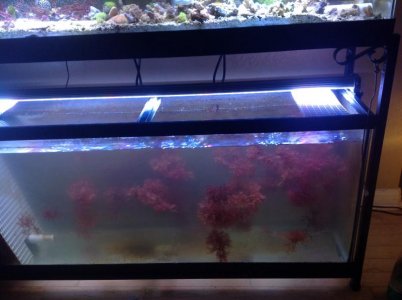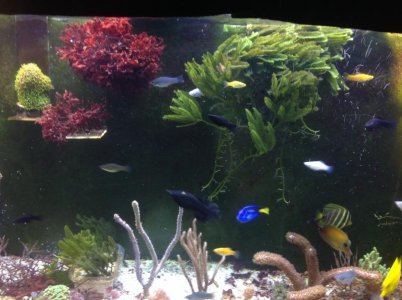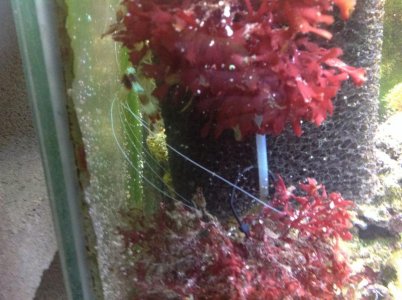Many hobbiest have found how fast macro can absorb nutrients by experiencing
"my macro went sexual". In most cases, they were using the macro to achieve low nutrient readings that they felt were required in their reef tank.
This thread will focus on the nutrient uptake of macro algae. Two years ago, I produced a five fold increase of Red Ogo each month. One pound of seed stock produced five pounds of harvest in a 75G tank using a tumble culture with 500W of 6500K MH. The production tank on my porch was coupled to my 10,000G greenhouse growout system. With such a large system, it was very forgiving on keeping up with nutrients required by macro algae in a 75G tank.
Macro algae harvested was Gracilaria Parvispora: Red Ogo or Tang Heaven Red.
Analysis was done by Ward Lab in Kearney, Nebraska.
Percentage results are dry basis:
Nitrogen. 2.59
Phosphorus. 0.082
Potassium. 13.54
Calcium. 0.555
Magnesium. 1.163
Sulfur. 4.81
Zinc, ppm. 139
Iron, ppm. 107
Manganese, ppm. 20
Copper, ppm. 7.0
"Miracle Grow" water soluble, all purpose plant food chemical analysis by percentage:
Nitrogen 24
Phosphate. 8
Potash. 16
Boron. 0.02
Copper. 0.07
Iron. 0.15
Manganese. 0.05
Molybdenum. 0.0005
Zinc. 0.06
Nitrogen source is Austin's Clear Ammonia: Ammonium Hydrixide at 1.5% concentrate.
In this particular sample of Red Ogo, the nitrogen to phosphate ratio is about 30:1. I will use that as my target goal for fertilizer.
"my macro went sexual". In most cases, they were using the macro to achieve low nutrient readings that they felt were required in their reef tank.
This thread will focus on the nutrient uptake of macro algae. Two years ago, I produced a five fold increase of Red Ogo each month. One pound of seed stock produced five pounds of harvest in a 75G tank using a tumble culture with 500W of 6500K MH. The production tank on my porch was coupled to my 10,000G greenhouse growout system. With such a large system, it was very forgiving on keeping up with nutrients required by macro algae in a 75G tank.
Macro algae harvested was Gracilaria Parvispora: Red Ogo or Tang Heaven Red.
Analysis was done by Ward Lab in Kearney, Nebraska.
Percentage results are dry basis:
Nitrogen. 2.59
Phosphorus. 0.082
Potassium. 13.54
Calcium. 0.555
Magnesium. 1.163
Sulfur. 4.81
Zinc, ppm. 139
Iron, ppm. 107
Manganese, ppm. 20
Copper, ppm. 7.0
"Miracle Grow" water soluble, all purpose plant food chemical analysis by percentage:
Nitrogen 24
Phosphate. 8
Potash. 16
Boron. 0.02
Copper. 0.07
Iron. 0.15
Manganese. 0.05
Molybdenum. 0.0005
Zinc. 0.06
Nitrogen source is Austin's Clear Ammonia: Ammonium Hydrixide at 1.5% concentrate.
In this particular sample of Red Ogo, the nitrogen to phosphate ratio is about 30:1. I will use that as my target goal for fertilizer.



